Effects of Excess Cu Addition on Photochromic Properties of AgCl-Urethane Resin Composite Films
Abstract
AgCl-resin photochromic composite films were prepared using AgNO3, HCl-EtOH, CuCl2 ethanol solutions, and a urethane resin as starting materials. The AgCl particle size in the composite films, which was confirmed via TEM observations, was 23–43 nm. The AgCl composite films showed photochromic properties: coloring induced by UV-vis irradiation and bleaching induced by cessation of UV-vis irradiation. The coloring and bleaching speed of the composite film increases with increasing CuCl2 mixing ratio.
1. Introduction
A glass doped with silver chloride shows photochromic properties [1, 2]. This phenomenon is effective for controlling the transmittance of solar light through glass windows. Photochromic materials containing AgCl nanoparticles have been fabricated as films [3], hybrid materials [4], and composite materials [5].


From this equation, the presence of Cu2+ in AgCl photochromic glasses causes the equilibrium in (2) to shift to the left-hand side, while the Ag0 formed by UV-vis irradiation is converted back to Ag+. In addition, the excess Cu2+ causes a decrease in the coloring speed and an increase in the bleaching speed of AgCl [6].
In a previous study, we fabricated AgCl-containing composite films and evaluated the photochromic properties of the films [5]. A Cu sensitizer was added to the AgCl composite films using only a CuCl2 (Cu2+) source. However, the Cu2+ ions acted as coloring and bleaching sensitizers for the composite films, which is not in agreement with the results expected from (2). In this study, we fabricated AgCl-containing photochromic composite films with various Cu contents and observed the effects of excess Cu2+ ions on the photochromic properties of the composite films.
2. Experimental Procedure
AgNO3 (99.5%; Wako Pure Chemical Industries Ltd., Osaka, Japan), HCl-EtOH (0.1 mol/L; Sigma-Aldrich Japan K.K., Tokyo, Japan), CuCl2 (95%; Wako Pure Chemical Industries Ltd., Osaka, Japan), and a liquid-state urethane resin (M-40, density of 1.15 g/cm3; Asahi Kasei Chemicals Corp., Tokyo, Japan) were used as starting materials. The urethane resin can be cured using UV-vis irradiation. AgNO3 powder was dissolved in ethanol at a concentration of 0.1 mol/L. The AgNO3 solution thus prepared was mixed with a liquid urethane resin (the Ag ion concentration in urethane resin was 1.0 μmol/cm3), and the HCl-EtOH solution was added sequentially to the mixture with a Cl/Ag atomic ratio (Hereinafter, described as “Cl/Ag ratio”) of 1.0 to form AgCl nanoparticles. CuCl2 powder was dissolved in ethanol at various concentrations, and the solution was added to the resulting mixture with varying Cu/Ag atomic ratios (Hereinafter, described as “Cu/Ag ratio”) ranging from 0 to 10. These mixtures were stirred, and, thereafter, the precursor solution was prepared. The mixture was degassed for 30 min at 100 kPa, and the resulting mixture was formed to a thickness of 1 mm using slide glasses. The precursor films were cured using UV-vis irradiation (with a low-pressure Hg lamp) for 5 min, thus producing composite films.
The transmission spectra of the obtained composite films were measured using a spectrophotometer (UV-1600; Shimadzu Corp., Japan) at a wavelength range of 200–1100 nm. Hg lamp was used for measuring the photochromic properties. To observe the microstructure of the films, the obtained sample was ground with an agate mortar, and the ground sample powder was supported by a copper grid. The microstructure of the composite films was then observed using transmission electron microscopy (TEM, EM-002B; Topcon Corp., Japan).
3. Results and Discussion
The as-prepared films were brown because the precursor films had been cured using UV-vis irradiation, and the composite film was colored. The darkened films were bleached in a dark room for 7 days, and the resulting transparent films were used to evaluate the photochromic properties. Figure 1 shows the transmission spectra for a representative composite film (Cu/Ag ratio of 1.0) measured before and after UV-vis irradiation for 1–20 min. As shown in the figure, the transparent composite film was colored by UV irradiation. Therefore, the resulting composite film shows photochromism. The inset photographs in Figure 1 show the film before and after UV-vis irradiation. The film showed coloring because of irradiation, and the colored film showed broad absorption at the absorption peak of 450 nm.
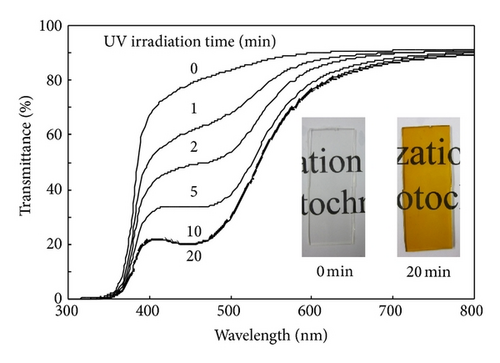
Figure 2 presents the coloring and bleaching properties of the films with Cu/Ag ratios ranging from 0 to 10; the employed wavelength was 450 nm. The coloring property was evaluated with the time interval of 1 min. Increasing Cu contents in the composite films caused a slightly decrease of the transmittance at the bleached condition. Though we are considering the reason, it is assumed that excess Cu contents affect the initial transmittance of the composite films, for example, deterioration or coloration of the matrix by existence of excess Cu ions and so on.
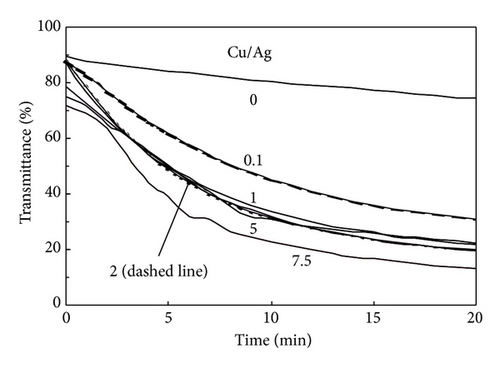
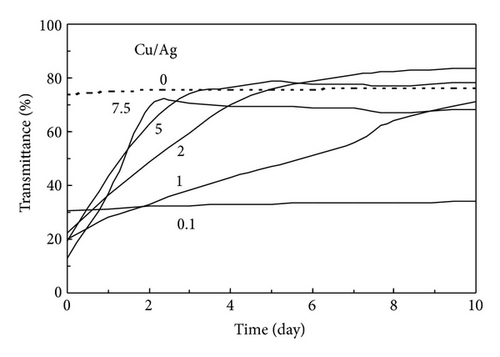
In the case of bleaching, increasing the Cu/Ag ratio in the films resulted in an increase in the bleaching speed. To compare the bleaching speeds of the films semiquantitatively, we calculated the half-life period of the films τ(h), where τ was the time taken from the transmittance of the sufficiently coloring state (20 min UV-vis irradiation) to the transmittance of the on a half of its initial state. The calculated half-life periods τ of the films with Cu/Ag ratios of 1, 2, 5, and 7.5 were 144, 56.9, 29.8, and 28.0 h, respectively; the films with Cu/Ag ratios of 0 and 0.1 did not return to the initial state in 10 days. Therefore, increasing the Cu/Ag ratio in the films resulted in a decrease in the half-life periods τ corresponding to the bleaching speed. The acceleration of the bleaching speed with the addition of Cu2+ agreed with the result expected from (2). Furthermore, CuCl2 was used as a source material, and, thus, the Cl concentration in the composite film increased slightly with an increase in the Cu concentration in the film. In addition, according to (1), the equilibrium in the composite film shifted to the right-hand side, and it was assumed that the bleaching speed increased.
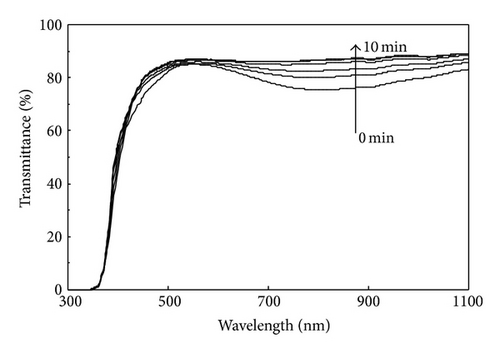
Generally, the particle size of AgCl in photochromic glasses is less than tens of nanometers [6, 12]. To confirm the AgCl particle size in the composite films and the effects of Cu addition on the AgCl particle size, the microstructure of the composite films was evaluated using TEM. Figure 4 shows the bright field TEM images of the composite films with Cu/Ag ratios of 0.1 and 10. The average AgCl particle sizes in the composite films with Cu/Ag ratios of 0.1 and 10 were approximately 23 and 43 nm, respectively, and were close to the AgCl particle sizes (30–50 nm) of silver chloride containing photochromic glasses [12]. The AgCl particle size in a film with a Cu/Ag ratio of 10 (including excess Cu ions) was 1.8 times larger than that in a film with a Cu/Ag ratio of 0.1. The AgCl particle size in the composite films was larger than that with the Cu/Ag ratio, and, thus, it is assumed that the coloring and bleaching speeds also depended slightly on the AgCl particle size in the composite.
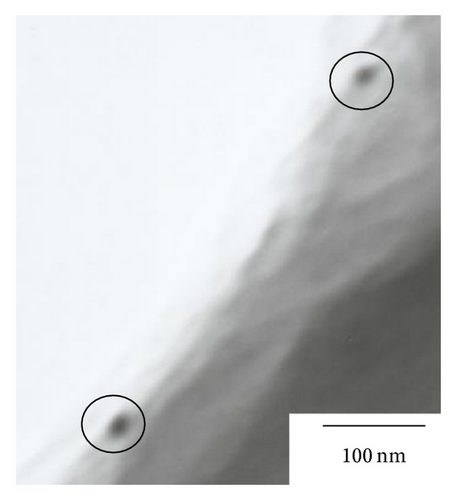
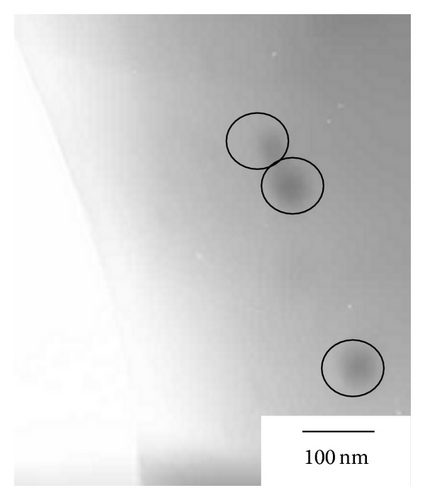
4. Conclusion
In this study, AgCl-based photochromic composite films were fabricated, and the effects of the Cu2+ sensitizer on the composite films were evaluated. Additive Cu2+ ions acted as coloring and bleaching sensitizers in the AgCl photochromic composite films, which is different from the case of AgCl photochromic glasses. Cu2+ ions in the composite film were reduced to Cu+ by UV-vis irradiation, and the reducing speed was faster than that of Ag+ to Ag. The generated Cu+ ion acted subsequently to reduce Ag+ ions, and thus the coloring speed of the composite films was accelerated. The AgCl particle sizes in the composite films were 23–43 nm and were close to those of silver-chloride-based photochromic glasses. The AgCl particle sizes in the composite films depended slightly on the Cu concentration in the film.
Conflict of Interests
The authors state that they have no conflict of interests.




